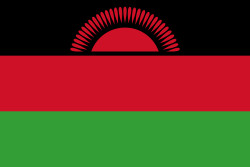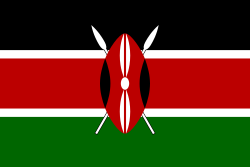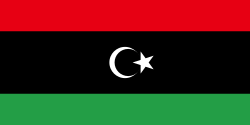
The Pan-African flag, also referred to as the UNIA flag, Afro-American flag or Black Liberation Flag, is a tri-color flag consisting of three equal horizontal bands colored red, black and green. It was originally created as the official banner of the African Race by the members of the Universal Negro Improvement Association and African Communities League (UNIA). The organization formally adopted it in article 39 of the Declaration of Rights of the Negro Peoples of the World [1] on August 13, 1920, during its month-long convention held at the Madison Square Garden in New York City, United States.[2][3] The flag can and has been used to represent African or African American unity or pride.
Meaning and history
The three colors represent the following:
- red: the blood that unites all people of African ancestry, and shed for liberation;
- black: black people whose existence as a nation, though not a nation-state, is affirmed by the existence of the flag; and
- green: the abundant natural wealth of Africa;
According to UNIA (Universal Negro Improvement Association and African Communities)
- red: "color of the blood which men must shed for their redemption and liberty"
- black: black for "the color of the noble and distinguished race to which we belong," and
- green: "the luxuriant vegetation of our Motherland."
The flag was created in 1920 by the members of the UNIA in response to the enormously popular 1900 coon song "Every Race Has a Flag but the Coon",[4] which has been cited as one of the three coon songs that "firmly established the term coon in the American vocabulary". A 1921 report appearing in the Africa Times and Orient Review, for which Marcus Garvey previously worked, quoted him regarding the importance of the flag:

Show me the race or the nation without a flag, and I will show you a race of people without any pride. Aye! In song and mimicry they have said, "Every race has a flag but the coon." How true! Aye! But that was said of us four years ago. They can't say it now....
Alternatively, it has been explained by journalist Charles Mowbray White that Garvey proposed the colours for the following reasons: "Garvey said red because of sympathy for the 'Reds of the world', and the Green their sympathy for the Irish in their fight for freedom, and the Black- [for] the Negro."[5]
The flag later became an African nationalist symbol for the worldwide liberation of people of African origin. As an emblem of Black pride, the flag became popular during the Black Liberation movement of the 1960s. In 1971, the school board of Newark, New Jersey, passed a resolution permitting the flag to be raised in public school classrooms. Four of the board's nine members were not present at the time, and the resolution was introduced by the board's teen member, a mayoral appointee. Fierce controversy ensued, including a court order that the board show cause why they should not be forced to rescind the resolution, and at least two state legislative proposals to ban ethnic or national flags in public classrooms other than the official U.S. flag.
In the United States, the flag is presently widely available through flag shops or ethnic specialty stores. It is commonly seen at parades commemorating Martin Luther King, Jr. Day, civil rights rallies, and other special events.
The flag goes by several other names with varying degrees of popularity:
- the UNIA flag, after its originators;
- the Marcus Garvey flag;
- the Universal African flag;
- the International African flag;
- the Black Liberation flag;
- the Pan-African flag;
- the Black Nationalist, African Nationalist, or the New Afrikan Liberation flag.
Although other designs are also considered to be International African flags or Pan-African flags, the horizontal stripes of red, black, and green, originated by the UNIA in 1920, is the design most often referenced.
Similar flags

A Black Power flag is a variant of this flag with a raised, clenched fist centered over the red, black, and green stripes.
The Biafran flag another variant of this one, with a sunburst in the center.
The flag of Malawi is very similar, changed in 2010 to reflect the pan-African flag's order of stripes.

The African National Congress flag is three horizontal stripes, descending black, green, and dark yellow (gold).


The flag of Ethiopia and Eritrea is three horizontal stripes, descending green, yellow, red, with a light blue disk in the center blazoned with a yellow pentagram, with yellow single rays emanating from the angles of the pentagram and terminating before the edge of the disk. It is the oldest national flag in Africa, and the colors of its three horizontal bands are sometime referred to as the Pan-African colors.

The flag of the Kingdom of Libya (1951-1969) is coincidentally similar. The large central black stripe with the crescent and star was in origin the flag of Senussi flag used in Cyrenaica, while the green and red stripes represented Tripolitania and Fezzan respectively. It has continued to be used by the Libyan opposition to Muammar al-Gaddafi who deposed the former king, even by those who do not favor a restoration of the monarchy. It has seen widespread use during the 2011 Libyan uprising.
The Rasta flag is three horizontal stripes, descending green, yellow, and red. It is derived from the Ethiopian flag/Eritrean flag.


The United States Postal Service issued a stamp in 1997 to commemorate Kwanzaa with a painting by fine artist Synthia Saint James of a dark-skinned family wearing garments traditional in parts of Africa and fashionable for special occasions among African-Americans. The family members are holding food, gifts, and a flag. The flag in the stamp may have been meant to represent the Pan-African flag, However, instead of the stripes descending red, black, and green, the stamp's flag transposes the top two bands and descends black, red, and green.
In 2000, artist David Hammons created a work called African-American Flag, which is held by the Museum of Modern Art in New York City. Based on the standard U.S. flag, its stripes are black and red, the field is green, and the stars on the field are black.
In response to the controversy over the flying of the Confederate Southern Cross, an African-American run company called NuSouth created a flag based on the Confederate Naval Jack, with the white stars and saltire outline replaced by green and the blue saltire made black.
The Flag of Kenya is also very similar to the red, black and green flag.
The Flag of Saint Kitts and Nevis is also similar.
The flag of Pakistan Peoples Party is also similar.
Proposed holiday
June 14 is celebrated as Flag Day in the U.S. In 1999, an article appeared in the July 25 edition of The Black World Today suggesting that, as an act of global solidarity, every August 17 should be celebrated worldwide as Universal African Flag Day by flying the red, black, and green banner. August 17 is the birthday of Marcus Garvey.
See also
External links
- Afro-American flags at Flags of the World non-commercial vexillology site
- Sheet music from a Johns Hopkins University website
- Sheet music from the American Memory website of the Library of Congress
- 'Fly the Red, Black, and Green' article proposing holiday at The Black World Today, July 25, 1999
- Kwanzaa Stamp U.S. postage depicting similar flag, with explanatory press release
- MoMA Learning an educational exercise based on David Hammons' African-American Flag
- UNIA official website
- [1]
References
- ↑ Wikisource contributors, "The Declaration of the Rights of the Negro Peoples of the World," Wikisource, The Free Library, The Declaration of the Rights of the Negro Peoples of the World (accessed October 6, 2007).
- ↑ 25,000 NEGROES CONVENE :International Gathering Will Prepare Own Bill of Rights. 1920. New York Times (1857-Current file), August 2, Proquest (Last accessed October 5, 2007)
- ↑ Special to The Christian Science Monitor from its Eastern News Office 1920. NEGROES ADOPT BILL OF RIGHTS :Convention Approves Plan for African Republic and Sets to Work on Preparation of Constitution of the Colored Race Negro Complaints Aggression Condemned Recognition Demanded. Christian Science Monitor (1908-Current file), August 17, Proquest (accessed October 5, 2007).
- ↑ "New Flag for Afro-Americans," Africa Times and Orient Review 1 (October 1912):134; Cited in RACE FIRST: The Ideological and Organizational Struggles of Marcus Garvey and the Universal Negro Improvement Association (Westport, Conn.: Greenwood Press, 1987), p43.
- ↑ Garvey Papers Vol. 2, p. 603.
- "Black Flag," unattributed article in TIME Magazine, December 13, 1971. (re Newark school board controversy)
eo:Afrik-Usona flago it:Colori panafricani pt:Bandeira Pan-Africana ru:Панафриканский флаг
